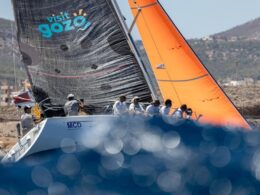Among the many aspects of our world under threat from climate change are the shipwrecks, temples, and tombs of the ancient world. Archaeological artefacts are preserved once they reach some form of stasis with their surrounding environment. Yet the tiniest of changes in that environment can completely destroy otherwise protected objects. Perhaps in no sub-discipline of archaeology is this threat more immediate than in maritime archaeology, where rising sea temperatures, rampant ocean acidification, deep sea mining, cable laying, pipeline projects, and even small-scale pleasure craft anchoring cast an ominous shadow over humanity’s shared maritime history.
In the Mediterranean, these threats combine to cause serious damage to the island’s Posidonia oceanica seagrass meadows and threaten its underwater archaeology. P. oceanica can protect archaeological materials like wood and ceramics from ocean currents, storms, and sea life, which often destroy those artefacts. P. oceanica has shielded several famous ancient shipwrecks and harbours from damage in the Mediterranean. Among these is a 3rd century CE Roman shipwreck in Malta known as the Mellieħa Bay Mortar Wreck, where researchers discovered dye from Egypt, hundreds of pieces of pottery from around the Mediterranean, and even a personal pendant to the Roman god, Sol Invictus. Beautiful artefacts like a Bronze Age wooden anchor and painted perfume jars in Turkish waters have been similarly protected by P. oceanica, as have ancient Greek wrecks and ancient military harbours in the Aegean.
P. oceanica is also Europe’s largest carbon sink, covering some 1.2 million hectares of the Mediterranean seafloor, but it is dying. The 2015 pan-European study ‘Seagrass meadows (Posidonia oceanica) distribution and trajectories of change’ found that nearly 33% of seagrass coverage across the Mediterranean has been lost since the 1970s. This reflects a global decline in seagrass coverage of similar severity. That 2015 study said that 1.5% of global seagrasses died per year. And while 21% of sites sampled in ‘Recent trend reversal for declining European seagrass meadows’in 2019 showed some sort of improvement, 49% of seagrass sites sampled in Europe were still in a state of decline. Estimates for seagrass decline are around 7% of coverage annually since the late 20th century. That’s almost 1.3 Real-Madrid football fields (10,700 m²) an hour. An incomprehensible number and an extremely devastating loss both environmentally and economically.
Ecological and cultural conservation should be emphasised more than cold, hard cash; that being said, seagrass conservation also has economic benefits. In another 2015 article, ‘The seagrass Posidonia oceanica: Ecosystem services identification and economic evaluation of goods and benefits’, researchersestimated that humans derive from P. oceanica between €28.5k–€51k per km2/year in economic goods and benefits. The EU estimated that the loss of this seagrass in the Gulf of Gabes in Tunisia alone resulted in €105 million in lost ecosystem services a year.
The loss of seagrass habitats threatens to expose underwater archaeological sites to the elements, which could cause serious damage: storms and wave action can shatter unsecured ancient pottery, certain sealife like the Teredo Worm can colonise exposed wood and completely destroy it in a few short years, and humans can easily loot such unprotected sites.
American naturalist John Muir once said, ‘When one tugs at a string in nature, one finds it connected to the rest of the world.’ Protecting P. oceanica is vital because of its critical ecological role and because it creates a region-wide vault in which thousands of years of humanity’s shared history has been stored. Underwater cultural heritage provides a unique view into our past global connections and can shed light on incredibly important cultural developments like Malta’s role in the Roman world. As seagrasses globally die and retreat, they could be exposing massive amounts of this heritage to the elements.
This article by Colan Llewellyn Mackenzie featured in Issue 46: Species of THINK Magazine, the official research magazine of the University of Malta. For more articles from the edition, pick up a copy on campus or read here. (Republished courtesy of THINK).










